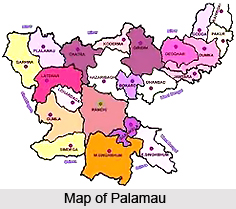 Palamau is situated within the lndo-Malayan realm and is rich in flora and fauna, though the area is prone to severe droughts. There are 107 villages in the buffer area and three in the core with a human population of 65,000 and a livestock population of 45,000. The core is distributed into two parts, the actual core and the recently inducted `satellite core`. The park was brought under Project Tiger in 1973 and is among the first nine Tiger Reserves of the country. The core area was declared a National Park in September 1989.
Palamau is situated within the lndo-Malayan realm and is rich in flora and fauna, though the area is prone to severe droughts. There are 107 villages in the buffer area and three in the core with a human population of 65,000 and a livestock population of 45,000. The core is distributed into two parts, the actual core and the recently inducted `satellite core`. The park was brought under Project Tiger in 1973 and is among the first nine Tiger Reserves of the country. The core area was declared a National Park in September 1989.
Location
The Palamau National Park is located in the eastern Indian state of Bihar and is in the western part of the Chotanagpur plateau. The region extends from the latitude 23°25`-23°55` in the North to the longitude 83°50`-84°25` in the East.
Excursion
The world. s first tiger-census, based on pugmark count, was done in the Palamau forests in 1932. One can drive through patches of dense sal and bamboo forests in the park. Tiger, panther, slothbear, gaur, Indian porcupine, wolf, wild boar, dhole (wild dogs), chinkara, sambar, mouse deer and pangolin find refuge in these forests. Elephants appear during the monsoon with the availability of water. During the rest of the months, the water sources dry up and the park faces acute water-scarcity. The park is spread over a core area of 250 square kilometers and is also known as the Betla National Park. Peafowl, red jungle fowl, and partridges are the common birds here.
A ride into the Tiger Reserve is quite exciting, if not always rewarding. One can hire a guide and a jeep from the forest department. The core of the forest is not open to tourists. Watch towers and ground hides have been created to see the wildlife in relative stillness and safety.
There are two large forts looming in lonely isolation deep in the forests. These forts are said to have been built by the Adivasi kings of the Chero dynasty. Raja Medhni Raj, the ruler of Chotanagpur began the construction and the task of completing the forts was left to his son Pratap Raj while the father battled with invaders. The main sentinel of the old fort is visible high up on the hill. It has defences in three directions, and three main gates, the largest named Singh Dwar (Lion Gate). The Nagpuri Gate has two inscriptions in Sanskrit and Persian. On the imposing main gate of the lower fort, some embellishments in blue tile are still intact. The architecture is very Islamic which speaks of Daud Khan. s conquest. During the British times a sum was paid regularly for the upkeep of the forests and a lot of excavation and restoration was carried out.
Places Nearby
In the surrounding areas of the Palamau Wildlife Sanctuary is Ranchi around 140 km away. The city was, during the British Raj, the summer capital of Bihar state and is now all set to become the capital of the newly proposed Jharkhand state.
The Hazaribagh National Park close by has an ecosystem and inhabitants similar to that of Palamau, but is smaller in size.
Netarhat, the Queen of Chotanagpur. is situated at an elevation of 3,700 feet above sea level. Here, one is exposed to abundant lush greenery and great landscape.
Flora
The vegetation in this region comprises moist deciduous and dry deciduous forests and includes sal and bamboo as the major components. The western part of the Reserve is composed of dry deciduous forests and the other part shows characters of moist mixed deciduous nature. The entire area has a good distribution of bamboo breaks. The herbarium recently prepared by the Tiger Reserve authorities records a good number of medicinal plants.
Fauna
At the last count, there were around 44 tigers in the park. Other important inhabitants of the sanctuary are wolves, hares, chital, nilgai, monkey, common langur, gaur, leopard, and sambar. Elephants are also seen in large numbers in the park.
Getting There
By Air
Ranchi, situated around 140 km away, is the nearest airport with regular air connections to Delhi, Calcutta, Patna and Lucknow.
By Rail
The nearest important railway station is Daltongunj, connected to many places in the region with regular trains. Ranchi and Gaya are also convenient railway stations for the tourists coming from Delhi and Calcutta respectively.
By Road
The sanctuary is well connected to other cities in the region by regular buses run by the state transport corporation and private companies.



















